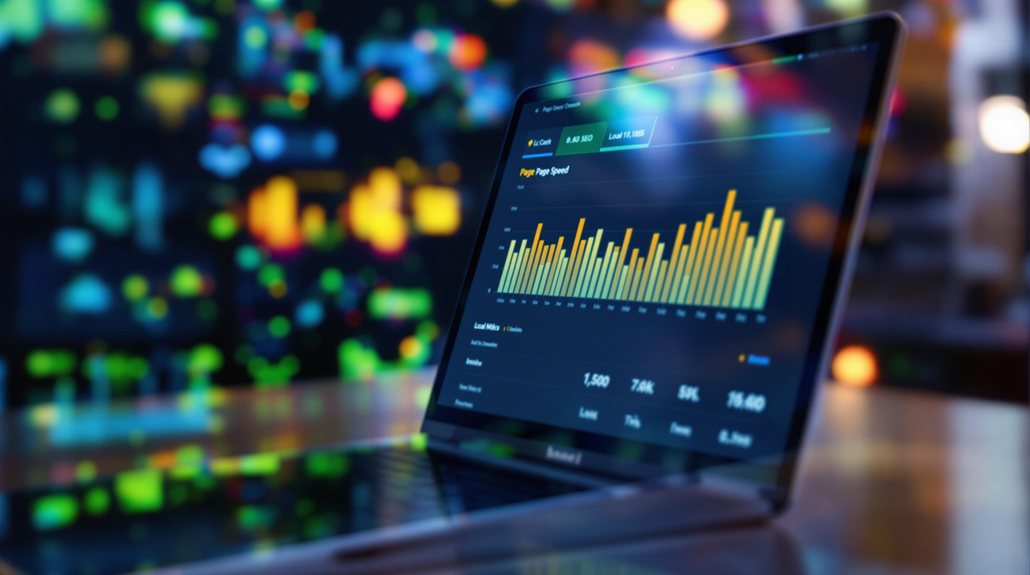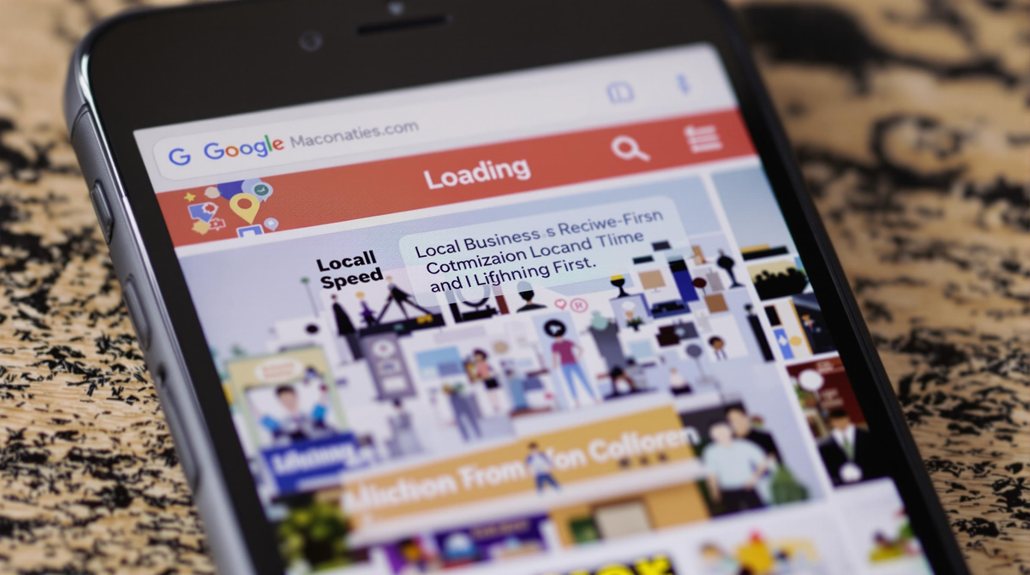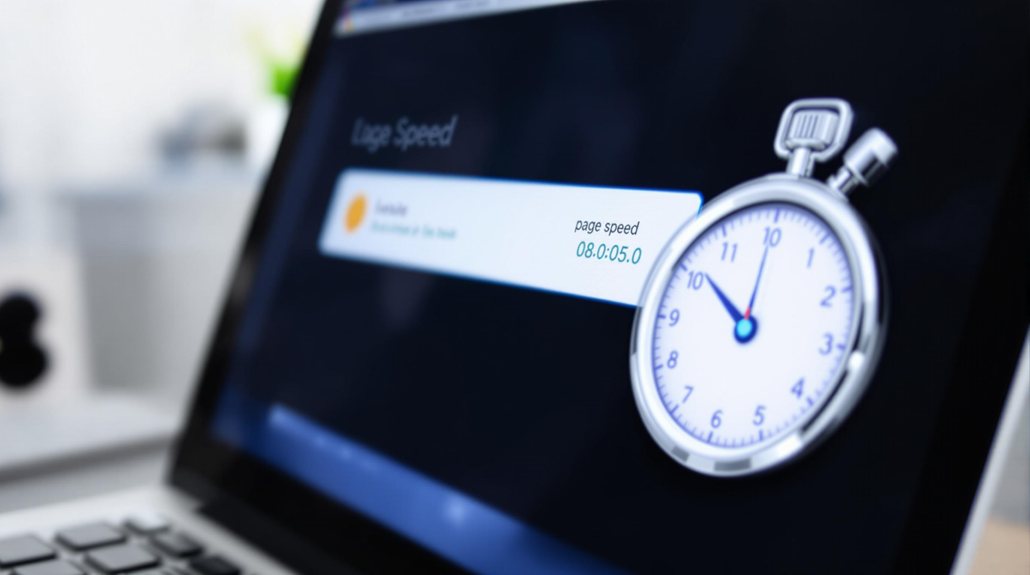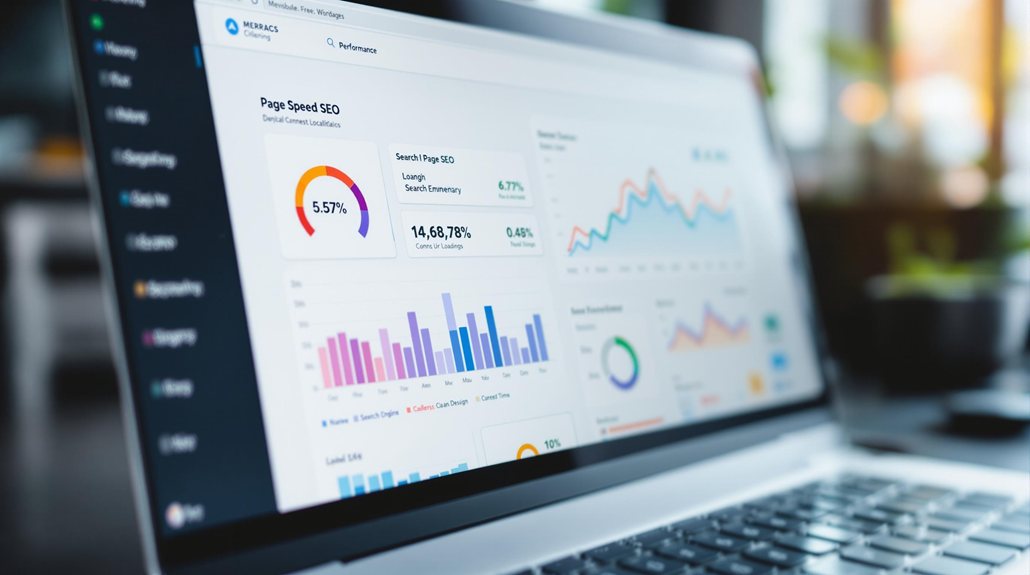Your website's page speed is crucial for local SEO. Slow-loading pages can cost you up to 53% of mobile users and 40% of desktop users. Faster sites enjoy 35.2% higher engagement rates and better conversions. Google prioritizes fast-loading pages, making speed a key ranking factor. Optimizing your site's architecture, images, and scripts can boost page speed, improving user experience and search visibility. If you want to learn more about enhancing your local SEO content through page speed optimization, keep reading.
The Impact of Page Speed on User Experience and Engagement

Although page speed may seem like a technical detail, its impact on user experience and engagement is profound. If your page takes over 3 seconds to load, you'll lose up to 53% of mobile users and 40% of desktop users. Worse, slow sites lead to higher bounce rates, lower engagement, and negative perceptions of your brand. Conversely, faster sites enjoy a 35.2% higher engagement rate. Even a 1-second delay can reduce conversions by 2.11%. Websites with faster load times have 35.2% higher page engagement rates. With Google prioritizing page speed, faster sites rank better in search, attracting more traffic. In today's competitive landscape, optimizing page speed is crucial for retaining users, boosting conversions, and improving your local SEO.
Optimizing for Mobile-First Indexing and Responsiveness

With over 63.38% of web searches conducted via mobile devices, optimizing for mobile-first indexing and responsiveness is crucial for your local SEO success. Google's mobile-first indexing prioritizes mobile content, making mobile-friendliness and page speed essential ranking factors. To excel in local SEO, focus on:
- Implementing Accelerated Mobile Pages (AMP) to enhance page speed and user experience
- Ensuring your website is responsive and adapts seamlessly across devices
- Leveraging structured data to improve search visibility and earn rich snippets
- Addressing content discrepancies between mobile and desktop versions can affect rankings.
Page Speed as a Recognized Search Engine Ranking Factor

Page speed has long been recognized as a crucial search engine ranking factor. Google first announced it as a ranking signal in 2010 and doubled down in 2018 by making it a mobile ranking factor too. Slow-loading sites may now rank lower, as Google prioritizes websites that provide a satisfying user experience through speed. Faster websites can lead to higher conversion rates, with a 1-second delay resulting in a 7% decrease in conversions. Core Web Vitals, such as loading, interactivity, and visual stability, have become key metrics influencing ranking decisions. Optimizing your site through techniques like image compression, code minification, and efficient caching can boost your page speed and, in turn, your local SEO performance. Regularly monitoring your site's speed and addressing any issues is essential for maintaining a competitive edge.
Meeting the Needs of Local Search Intent and Behavior Patterns
Your local customers have urgent information needs. Local search intent is crucial for meeting those needs. Slow page speeds could deter them and hurt your conversion metrics. Optimizing for local search intent and user behavior is key to delivering a positive experience.
Urgent Information Needs
When it comes to local SEO, understanding the urgency behind search queries is crucial. Users conducting local searches often have immediate needs, whether it's finding a nearby open business or accessing emergency services. To cater to these high-intent users, your content must be:
- Easily Accessible: Ensure your website loads quickly, especially on mobile devices, to provide a seamless user experience.
- Prominently Displayed: Optimize your Google My Business listing and leverage location-specific keywords to improve your visibility in urgent search results.
- Tailored to Urgency: Anticipate and address the specific needs of your target audience, whether it's providing business hours, contact information, or a clear call-to-action. Local search intent plays a key role in understanding and meeting these urgent information needs.
Deter Potential Customers
A slow-loading website can deter potential customers who are searching for local services, as they typically expect quick and accessible information. Studies show that a one-second delay can impact conversion rates by up to 20%, emphasizing the need for fast page speeds to retain local customers. Users experiencing delays may return to search results, choosing a competitor's site instead, negatively affecting your engagement metrics. Slow sites unlikely to rank well in local search if page speed is not optimized.
| Local Search Behavior | Impact on User Experience | Effect on Local SEO |
|---|---|---|
| Immediate needs | 53% of mobile visits abandoned if pages take >3 seconds | Slow sites unlikely to rank well |
| Preference for quick, relevant results | 7% drop in conversion rates with 1-second delay | Core Web Vitals scores suffer |
| Mobile-first mindset | Up to 27% increase in conversion for 1-second faster load | Lower rankings and visibility |
Positive User Metrics
By meeting the needs of local search intent and understanding user behavior patterns, you can positively impact your local SEO performance. Optimizing for user experience is key, as search engines analyze metrics like click-through rates, dwell time, and pages per session to evaluate content relevance. Analyze website performance metrics to ensure your local content loads quickly and provides a seamless mobile experience. Consider these factors:
- Enhance engagement with locally-tailored, mobile-responsive content that loads quickly.
- Leverage positive reviews and ratings to build trust and credibility.
- Continuously monitor user behavior to refine your strategies and improve local SEO rankings.
Prioritizing positive user metrics will help you deliver exceptional experiences, boosting your visibility in local search results.
Enhancing Site Architecture for Improved Page Load Times
Enhancing your site's architecture is crucial for improving page load times. Minimizing redirects and flattening your site's structure can enhance navigation and reduce browsing time. Streamlining your navigation with clear, concise links allows users to find content faster. Removing unnecessary elements and adopting simpler, more responsive layouts contribute to faster loading and better user engagement. Faster page speeds make it easier for Google to crawl and index law firm pages. Prioritizing critical resources through lazy loading and deferring non-essential scripts can significantly boost your initial page load speeds. By optimizing your site's architecture, you'll deliver a seamless experience that keeps users engaged and improves your local SEO performance.
Leveraging Technical SEO Techniques to Boost Speed
While optimizing your site's architecture lays the foundation for faster page speeds, leveraging technical SEO techniques can further bolster your performance. Consider these impactful strategies:
- Minify and Compress Assets: Minifying your CSS, JavaScript, and HTML, as well as compressing your images, can significantly reduce file sizes and accelerate load times.
- Implement Efficient Caching: Properly configuring browser caching policies ensures returning visitors experience lightning-fast page loads, enhancing user experience and search engine perception.
- Optimize Server-Side Processing: Identifying and addressing server bottlenecks, upgrading hosting, and leveraging a content delivery network (CDN) can all contribute to improved response times and better overall performance.
The Correlation Between Page Speed and Conversion Rates
Boosting your conversion rates and profits isn't just about clever marketing; it's also about optimizing your website's speed. Increased sales and conversions with fast page speed. After all, faster page loads lead to higher engagement and fewer abandoned shopping carts. Prioritize page speed, and you'll gain a clear competitive edge in the local market.
Faster Conversions, Higher Profits
When your website loads quickly, it can significantly improve your conversion rates. Faster pages lead to higher engagement and lower bounce rates, as users expect websites to load in two seconds or less. Even a one-second delay can result in a 7% drop in conversions. By optimizing your website for speed:
- You'll enhance user trust and reliability, boosting sales conversions.
- You'll reduce friction and improve the likelihood of converting visitors into customers.
- You'll prioritize mobile page speed, as faster mobile sites foster user loyalty and trust.
Prioritizing page speed optimization is crucial for increasing profits and driving better results for your local SEO content.
Speed Boosts Business Performance
Page speed is intricately linked to business performance. The faster your pages load, the better your user experience and the higher your conversion rates. In fact, a 1-second delay can reduce conversions by 7%. Even a 3-second delay can result in a 20% decrease in conversions. Mobile users are especially sensitive to slow page speeds, with 53% abandoning sites that take longer than 3 seconds to load. Optimizing your pages, using a CDN, and regularly testing load times are crucial strategies to boost your conversion rates and drive better business outcomes. Improving page speed is an investment that pays dividends in increased revenue and profitability.
Optimize Conversion With Speed
Undoubtedly, a faster loading page can significantly boost your conversion rates. Data shows a 1-second delay reduces conversions by 7%, and every additional second increases the likelihood of a higher bounce rate. With nearly half of consumers expecting pages to load in 2 seconds or less, and mobile users being less tolerant of slow pages, optimizing your page speed is crucial.
- Improved user engagement and satisfaction lead to higher conversions.
- Faster pages enhance user experience, trust, and brand loyalty.
- Page speed optimization is essential for providing an optimal experience across devices.
Enhancing Local Business Visibility Through Fast-Loading Pages
As a local business, ensuring your website loads quickly is paramount for enhancing your visibility and attracting potential customers. Quick-loading sites are essential for local SEO, as they not only improve user experience but also boost your search engine rankings. By prioritizing page speed optimization, you can gain a competitive edge in your local market, outperforming larger corporations. Leveraging techniques like image compression, caching, and code cleanup can dramatically reduce loading times, making your website more accessible and trustworthy. With a fast-loading site, you'll see increased organic traffic, lower bounce rates, and higher conversion rates – all of which are vital for the success of your local business.
Minimizing HTTP Requests for Faster Page Loading
To speed up your local SEO content, minimize HTTP requests by reducing resource requests, optimizing file sizes, and leveraging caching techniques. Combining files, compressing images, and implementing browser caching can significantly improve your page load times. These strategies will enhance the user experience, boost engagement, and positively impact your search engine rankings.
Reduce Resource Requests
Reducing the number of HTTP requests can significantly improve your website's page speed and overall performance. By understanding the impact of resource requests on metrics like Time to First Byte (TTFB) and Largest Contentful Paint (LCP), you can optimize your site for better user experience and search engine visibility. Strategies to reduce resource requests include:
- Merging CSS and JavaScript files to minimize the number of downloads
- Leveraging lazy loading techniques to defer the loading of non-critical assets
- Utilizing a Content Delivery Network (CDN) to serve static resources from geographically closer servers
Implementing these tactics can have a direct effect on your local SEO, as faster-loading pages are more likely to rank higher and engage local users, ultimately boosting your business's online presence.
Optimize File Sizes
When it comes to optimizing file sizes for local SEO, you'll want to focus on selecting the most suitable image formats. JPEG is best for photographs, offering good quality with smaller file sizes. PNG is ideal for images with transparency, like logos, though typically larger than JPEGs. WebP provides high-quality images with smaller file sizes if browser support exists. Compressing images with tools like TinyPNG, ImageOptim, and ShortPixel can also effectively reduce file size without losing quality. Resizing images to their intended display size is crucial, as is balancing quality and size to optimize load times. Faster pages enhance user experience and search rankings, making image optimization a key factor for local SEO success.
Leverage Caching Techniques
Caching is a powerful technique that can significantly reduce page load times and enhance the overall user experience on your local SEO content. By storing frequently accessed resources locally, you can minimize the need for repeated downloads, improving bandwidth efficiency and server performance. This, in turn, alleviates server load and ensures faster load times, which are crucial for SEO and user engagement.
Consider these key benefits of leveraging caching techniques:
- Faster page loads for returning visitors by storing static assets like images, CSS, and JavaScript files.
- Reduced database queries and API calls through object and database caching.
- Enhanced global content delivery by utilizing edge caching with content delivery networks (CDNs).
Implementing robust caching strategies is essential for delivering an exceptional local SEO experience.
Optimizing CSS and JavaScript for Reduced Load Times
Placing JavaScript files before the closing body tag and CSS in the head ensures proper page rendering. Use the async or defer attributes to load scripts asynchronously or defer their execution, reducing render-blocking. Minify code, combine files, and employ bundling tools to shrink file sizes. Write efficient JavaScript and optimize HTML templates for faster DOM manipulation. Implement lazy loading for non-critical assets and utilize prefetching techniques to prepare resources in advance. These optimizations boost page speed, benefiting both user experience and SEO. Regularly review code, monitor performance, and make adjustments to continually enhance your website's loading times.
Implementing Server-Side Caching and Content Delivery Networks
Efficient server-side caching and the strategic implementation of Content Delivery Networks (CDNs) can significantly enhance your website's performance and responsiveness. Caching reduces latency, improves performance, and increases scalability, while also lowering operational costs and enhancing the user experience. Leveraging Nginx for server-side caching further optimizes web server responsiveness and load times. Additionally, CDNs distribute content globally, delivering faster page loads and improved reliability during traffic spikes.
Consider these key benefits of caching and CDNs:
- Faster content delivery for improved user engagement and SEO performance
- Reduced server load, enabling efficient resource utilization
- Enhanced security through CDN-based protection mechanisms
Implementing a hybrid approach that combines server-side caching and CDNs can provide the optimal solution for your local SEO content strategy.
The Impact of Compressed Images on Page Speed
Optimizing image compression is key to minimizing page load times. Leveraging the right file formats and compression tools can significantly reduce image file sizes without impacting quality. Ensuring your visual content is properly optimized is a powerful way to boost your local SEO content's performance.
Optimizing Image Compression
As a website owner, the impact of compressed images on your page speed cannot be overstated. Optimizing image compression is crucial for delivering a seamless user experience and boosting your local SEO rankings. Key strategies include:
- Selecting the right image format (e.g., JPEG for photos, PNG for graphics) to balance compression and quality.
- Leveraging automated tools to ensure consistent optimization across your website.
- Integrating Content Delivery Networks (CDNs) to further enhance page load times.
Maintaining this delicate balance between compression and quality is essential. By mastering image optimization, you can drive faster page speeds, improve Core Web Vitals, and ultimately, convert more local customers.
Minimizing Load Times
The impact of compressed images on your page speed cannot be overstated. Optimizing image file sizes can lead to significant reductions in overall page load time, ensuring your site loads quickly and responsively. Faster load times directly improve Core Web Vitals metrics like Largest Contentful Paint, boosting your SEO rankings. Moreover, your visitors will enjoy a seamless browsing experience, reducing bounce rates and increasing engagement. From mobile-friendly pages to efficient content delivery, compressed images are crucial for an exceptional user experience. Leverage tools like Google PageSpeed Insights to monitor your progress and aim for load times under 2 seconds – the sweet spot for optimal performance and conversions.
Monitoring and Optimizing Site Speed for SEO Success
Why is monitoring page speed crucial for SEO success? Google prioritizes fast-loading pages, making speed a key ranking factor. Leveraging tools like Google PageSpeed Insights, Core Web Vitals, and Pingdom can provide actionable insights to boost your site's performance.
To optimize for SEO success:
- Identify speed bottlenecks using WebPageTest and HTTP Archive to diagnose issues.
- Implement real-user monitoring through Google Search Console and Pingdom RUM for a comprehensive view of user experience.
- Ensure mobile-friendliness by aligning with Google's guidelines and testing with specialized tools.
Monitoring and optimizing site speed is essential for improving local SEO content and securing higher rankings on search engine results pages.
Prioritizing Page Speed Alongside Content Quality for Local SEO
While content quality remains the primary driver for search engine rankings, optimizing page speed is a crucial complementary factor, especially for local SEO success. Balancing these two elements ensures user satisfaction and encourages repeat visits. Fast-loading local business websites gain a competitive edge, attracting more traffic and improving customer retention. Ensuring optimal page speed on mobile devices is critical, as most local searches occur on the go. By synergizing quality content with swift load times, you can enhance local search visibility, elevate Google My Business integration, and deliver an exceptional user experience that keeps customers coming back.
Ensuring an Optimal User Experience Through Fast-Loading Pages
Providing users with a fast-loading, seamless experience is paramount for local businesses seeking to captivate and retain their audience. With 40% of online users abandoning a site that takes longer than three seconds to load, and a staggering 32% increase in bounce rate as load time grows from 1 to 3 seconds, fast page speed is a critical element of effective local SEO. Consider these key factors:
- Faster load times directly impact conversions, with each additional second decreasing conversion rates by up to 4.42%.
- Search engines prioritize sites that offer a smooth, fast user experience, using metrics like Largest Contentful Paint to measure key aspects of page speed.
- Optimizing resources, implementing caching techniques, and reducing ads can significantly improve your local SEO content's load times.
